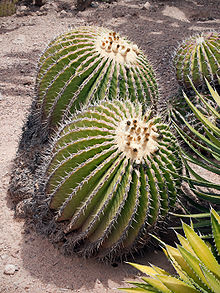
Selenicereus undatus, the white-fleshed pitahaya, is a species of the genus Selenicereus in the family Cactaceae and is the most cultivated species in the genus. It is used both as an ornamental vine and as a fruit crop - the pitahaya or dragon fruit.

Kroenleinia grusonii, popularly known as the golden barrel cactus, golden ball or mother-in-law's cushion, is a species of barrel cactus which is endemic to east-central Mexico.

Pachycauls are plants with a disproportionately thick trunk for their height, and few branches. In contrast, trees with thin twigs such as Oak (Quercus), Maple (Acer) and Eucalyptus are called leptocauls while those with moderately thick twigs like Plumeria are called mesocauls. Pachycauly can be the product of exceptional primary growth or disproportionate secondary growth as with the Baobabs (Adansonia). The word is derived from the Greek pachy- meaning thick or stout, and Latin caulis meaning the stem. All of the tree species of cactus are pachycauls, as are most palms, Cycads and pandans. The most extreme pachycauls are the floodplains, or riverbottom variety of the African Palmyra with primary growth up to seven feet in thickness, and the Coquito Palm with primary growth up to six feet thick. The most pachycaulous cycad is Cycas thouarsii at up to five feet in diameter. The tallest pachycaul is the Andean Wax Palm at up to 220 feet. and about 16 inches (41 cm) in diameter. The most pachycaulous cactus is the Bisnaga with primary growth up to 4 ft 4 in in diameter. The largest caudex type pachycaul is the African Baobab. One called the Glencoe Baobab at Hoedspruit, South Africa has a basal diameter of 52 ft 2 in. This tree suffered a severe trauma and is dying.

Aporocactus martianus is a species of cactus found in Oaxaca, Mexico.
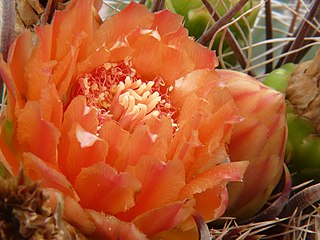
Ferocactus wislizeni, the fishhook barrel cactus, also called Arizona barrel cactus, candy barrel cactus, and Southwestern barrel cactus, is a species of flowering plant in the cactus family Cactaceae, native to northern Mexico and the southern United States. It is a ball-shaped cactus eventually growing to a cylindrical shape, with spiny ribs and red or yellow flowers in summer.

Ferocactus viridescens is a species of flowering plant in the cactus family Cactaceae. This rare barrel cactus is known by several common names, including coast barrel cactus, keg cactus and San Diego barrel cactus. Most of its native range in the United States is in San Diego County, California, where it is threatened by development, agriculture, and other alterations in its habitat. It is also found in northern Baja California, Mexico.

Mammillaria spinosissima, also known as the spiny pincushion cactus, is a species of flowering plant in the cactus family Cactaceae, endemic to the central Mexican states of Guerrero and Morelos, where they grow at elevations of approximately 1,600 to 1,900 metres. The species was described in 1838 by James Forbes, gardener of the Duke of Bedford. Botanist David Hunt collected a specimen in 1971, when he located one near Sierra de Tepoztlan, Mexico.

Opuntia robusta, the wheel cactus, nopal tapon, or camuesa, is a species of cactus in the family Cactaceae. It is native and endemic to central and northern Mexico to within 100 miles (160 km) of the Arizona and New Mexico borders where it grow from 5,000 to 10,000 feet on rocky slopes, open shrub lands, woodlands and mixed with other cactus and succulents.

Echinocactus horizonthalonius is a species of cactus known by several common names, including devilshead, turk's head cactus, blue barrel cactus, eagle's claw, horse maimer, horse crippler, and visnaga meloncillo. It is native to the southwestern United States and northern Mexico, where it occurs in Chihuahuan Desert and Sonoran Desert habitats, particularly on limestone substrates. One of its varieties is a federally listed endangered species of the United States.
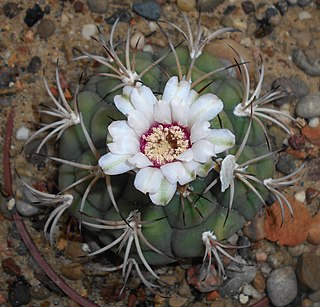
Gymnocalycium anisitsii is a globular cactus belonging to the family Cactaceae. The specific epithet honors the Hungarian pharmacist Dániel Anisits J. (1856-1911).

Mammillaria magnimamma, common name Mexican pincushion, is a species of flowering plant in the cactus family Cactaceae.
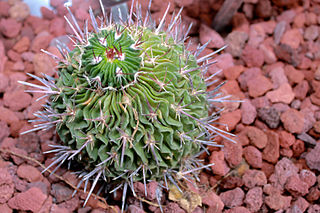
Stenocactus multicostatus, the brain cactus, is a member of the cactus family native to the deserts of Mexico, and is popular in the gardening community. It has gained the Royal Horticultural Society's Award of Garden Merit.

Ferocactus diguetii, commonly known as the giant barrel cactus, is the largest species of barrel cactus in the genus Ferocactus. It is an insular species endemic to several of Baja California Sur's southern islands in the Gulf of California. As the superlative giant of the barrel cacti, it reaches heights of up to 4 metres (13 ft) and diameters of 1 metre (3.3 ft) in the wild, a result of island gigantism. The species has red flowers that bloom from March to May. Although restricted in range, this species grows in protected habitat and lacks major threats.

Ferocactus townsendianus, commonly known as the Townsend barrel cactus, is a species of cactus endemic to southern Baja California Sur in Mexico. It is a barrel cactus that grows solitary stems up to 1 metre (3.3 ft) tall, with gray to brown spines, with one central spine on each areole usually curved or hooked at the tip, and orange to red flowers that bloom from May to August. Ferocactus townsendianus is similar to both Ferocactus peninsulae and Ferocactus santa-maria, and is sometimes placed under peninsulae as a variety or subspecies.

Ferocactus histrix, also known as Acitrón barrel cactus is a species of Ferocactus native to central Mexico. It is a large barrel cactus that can be commonly found throughout all the Central Mexican matorral. It produces an edible fruit appreciated for its sour taste.
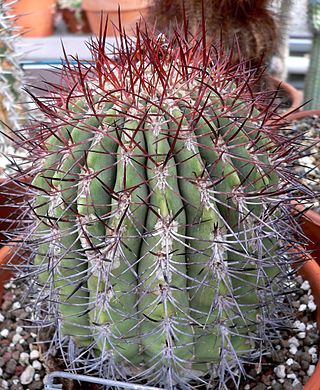
Denmoza is a monotypic genus of cacti. Its only species, Denmoza rhodacantha, is native to northwest Argentina.

Lobivia ferox, is a species of Lobivia found in Bolivia and Argentina.

Myrtillocactus cochal, the cochal or candelabra cactus, is a species of flowering plant in the family Cactaceae, native to the Baja California peninsula. Individuals can reach 3 m (10 ft), and are hardy to USDA zone 9b.
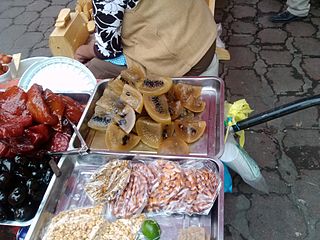
The acitrón is a Mexican candy which is commonly used as a decoration on a three kings' cake. As an ingredient, it has great cultural significance since it is used in a large number of ritual and festive preparations. Unfortunately, the biznaga cactus from which acitróns are made is an endangered species due to excessive consumption.

Ferocactus herrerae, commonly known as the twisted barrel cactus, Herrera's barrel cactus, or the biznaga, is a species of viviparous barrel cactus in the genus Ferocactus of the family Cactaceae that is native to southwestern Sonora to the northwestern coastline of Sinaloa in western Mexico. It was described by Mexican botanist, Jesús González Ortega in 1927. Its common name refers to its twisted, barrel cactus shape habit, with long, hooked, or barbed spines.
